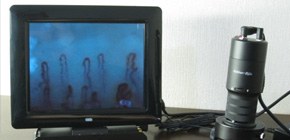
Successful digitization of capillary images in the fingertips
Will lead to the development of preventive methods for lifestyle diseases and early diagnosis based on objective evidence
Key points from the results of this study
- Indistinct fingertip capillary images obtained non-invasively were clearly extracted and successfully digitized
- Previous measurements by humans have taken about 5 minutes, whereas this system allows measurements to be made in 5 seconds
- The system is promising for the development of preventive methods for lifestyle diseases and other conditions and technologies that will lead to early diagnosis, based on objective scientific evidence
Summary
Associate Professor Naomasa Kawaguchi and Visiting Associate Professor Kazuaki Nakane of the Division of Health Sciences, Osaka University Graduate School of Medicine, supported by an Osaka city innovation-promoting subsidy, conducted joint research with At Co., Ltd. In this research, clear images of the capillaries alone were extracted from non-invasive (i.e., not requiring insertion of an instrument through an opening in the skin or body) subcutaneous capillary imaging. The images were then successfully digitized from automatic measurements of capillary length, thickness, and area. A “Capillary Analysis System” (CAS) equipped with this core technology was also developed, and in December 2015 a capillary image contract analysis service for researchers in medical and healthcare fields was started by At Co., Ltd. With this system, digitization that previously took about 5 min can be completed in 5 s.
The results of this study are promising for the development of preventive methods for lifestyle diseases and other conditions and for technologies that will lead to early diagnosis based on objective scientific evidence. Provision of devices like this to pharmacies, fitness clubs, and similar locations in the future would allow citizens to objectively measure their health status, and would provide promising tool to help raise health awareness.
Study background
Observation of fingernail bed capillaries was previously performed visually, with some observations incorporating semi-automated measurement of visual data. However, evaluations based on objective mathematical indices are still not performed. This is due to the fact that, in many cases, images obtained with capillary observation devices are indistinct, and the borders of capillaries cannot be clearly extracted. While studies that take hairpin shapes to be the normal state of capillaries have been published in Japan and other countries, it was not until the 1990s that studies identified a correlation with disease and there is little data other than that related to connective tissue diseases, such as scleroderma and chronic rheumatoid arthritis.
In this study, which was conducted jointly with At Co., Ltd. , the vessel portion of capillary images was successfully extracted using the mathematical method of reaction-diffusion equations for in vivo images (right figure).
These studies were carried out using simple technology that can easily digitize data to elucidate the relationship between peripheral capillaries and vital functions or diseases that have yet to be discovered.
Impact of this study's results on society (Significance of the results)
While there is a need for prevention due to increasing medical care costs, it remains difficult to effectively enhance people’s awareness of their own health. In the future, these devices will be provided not only to medical and health checkup facilities, but also to pharmacies, fitness clubs, and other public health facilities. These devices are promising for the development of preventive methods for lifestyle diseases and other conditions, and they demonstrate that technology can lead to early diagnosis based on objective (scientific) evidence, which is needed in the field of life innovation. Efforts in new areas of healthcare through industry-academia collaboration or the formation of consortia of regional small and medium-sized businesses will establish another business model and are expected to contribute to energizing the healthcare industry that is part of the national growth strategy, and to facilitating the provision of high-quality healthcare services.


Method to extract capillary image
(1) = Normal method, existing binarization
(2) = Special method, binarization with Joint Research
This research was featured in the Journal of Japan Mibyou System Association, Vol.21, No.2. 2015 (pp.98-102).
Related links

